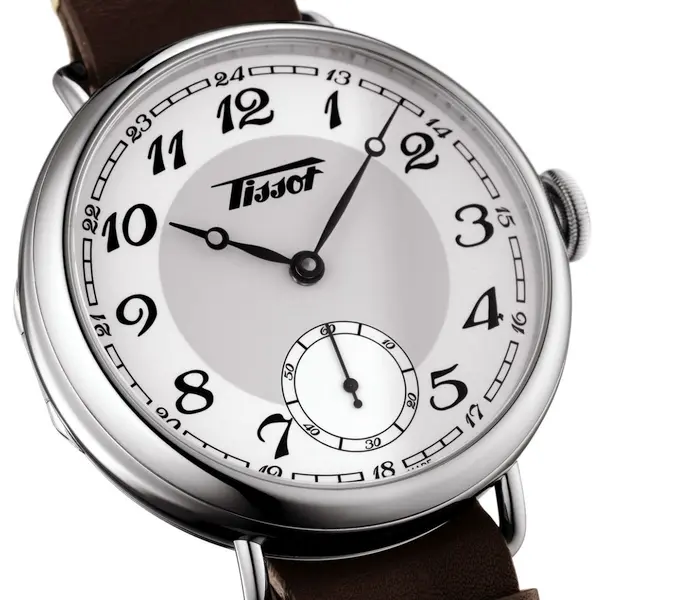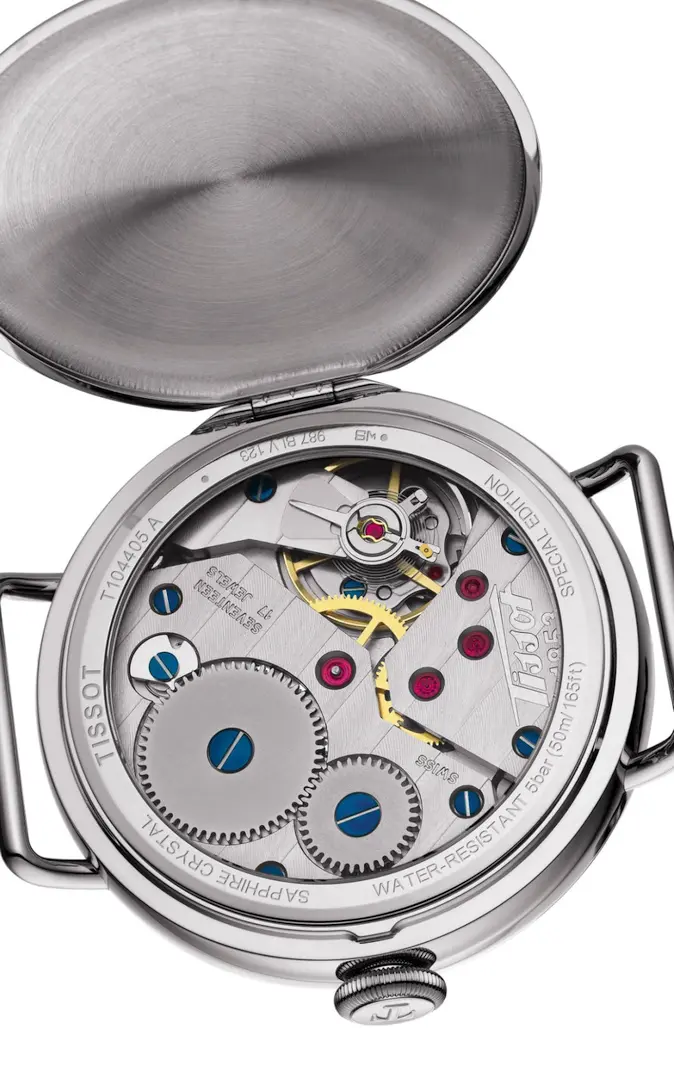
During the last three or four years, Tissot has introduced several great classic-styled timekeepers in their Heritage line. Among others, the collection included the stunning 2013 Heritage Navigator 160th Anniversary that still stays in production. For this year, the entry-luxury brand adds an even more impressive (although deceptively simple) hand-wound Heritage 1936 (ref. T104.405.16.012.00).
Staying true to the collection’s concept, the model combines a deliciously vintage appearance with a time-proven hand-wound caliber and more than attractive price. What else would you want for Christmas?
Overall Impression
The Swatch Group’s February 2016 earnings report stated that the conglomerate didn’t do well in 2015.
According to their press release, “operating margin was about 17% lower in comparison to the previous year” while net income plunged a whole 21 percent year-on-year basis. What’s even worse, so far there are still no signs of speedy recovery: the half-year report that the group has issued just yesterday on July 21 states a further decrease in sales of 11.4 percent even despite “double-digit growth in retail sales in Mainland China and Southeast Asia”.
Perhaps, this is exactly the reason why the Swatch Group has invested some serious cash into refreshing its model range across the board. Understanding that, given the current shape of the world economy, the usual “Swiss Made” inscription on a dial is not enough to sell a watch that costs like a modern UHD TV set, the Swiss Juggernaut started to make something that has some value besides a well-advertised brand name on its dial.
Unlike many “vintage-inspired” timekeepers that the Swiss-based brand has issued during the last decade, this Heritage 1936 is not a sort of a reproduction of an original model that was done using modern technology. However, it still didn’t just jump out of nowhere just to satisfy your need for another “classic” watch.

Judging by its exterior, the ref. T104.405.16.012.00 was heavily inspired by Tissot’s Art-Deco-era hand-wound pocket watches that, too, featured two-tone dials with a small seconds sub-dial that was usually placed at six o’clock, as well as Breguet-style Arabic numerals and hands.
Combine this styling with an archaic, yet still, full-of-life ETA/Unitas mechanism with a fairly basic, yet pleasant-to-look-at finish, put it in a smaller case with 1920s-style wire lugs, and you get an interesting timekeeper that will be immediately loved by dozens of thousands of enthusiasts searching for a vintage-styled dressy timekeeper to accompany their formal suits.
Case & Strap
At 45 millimeters in diameter and 13 mm thick, the stainless steel case of this model is on the larger side, but not excessively so. If you happen to have an average -or slightly larger- wrist, you will probably not experience any discomfort wearing this timepiece (although, as I always suggest in my reviews, you should always try one on your wrist to check how it feels on you.)
The secret is, of course, the wire lugs of medium thickness that are welded to the case at a comfortable angle. They not only allow you to choose a wider variety of straps when you get tired of the original one but also make the case visually shorter when it comes to the lug-to-lug department: compared to timepieces equipped with solid horns, these wire-style parts are almost invisible making the Heritage 1936 look lighter and somehow smaller.
The effect is also supported by the relatively thin bezel that, too, mimics the design of vintage pocket watches, and looks organic at that, too.
The Heritage 1936, like many post-WWI-era trench- and deck-inspired timekeepers that were introduced during recent years by many Swiss- and German-based brands, features a nice ‘hunter’ case back cover that not only protects the rear sapphire crystal from scratches but also adds a certain ‘classiness’ to the overall vintage aura.
Thanks to the choice of a large mechanical movement (see below,) the back, too, looks natural and sort of authentic: something that you rarely see in the world where deliberately oversized timekeepers are often animated by small self-winding calibers that look as aesthetically pleasing as a coin in the barrel and as pertinent as a midget on a Harley.
Perhaps, my only gripe with the ref. T104.405.16.012.00’s ergonomics is the flattened shape of the winding/setting crown. While looking cool, it makes it a bit difficult (and haptically unpleasant) to operate the part every time you need to adjust the hands. Otherwise, everything looks golden.

The case comes equipped with something that looks like a Zulu strap (and you will probably want to replace the original with a real Zulu band crafted from distressed leather and featuring a used-look metal ring to make the piece even more convincing) and makes an impression of a product of at least decent quality.
As usual, this is a matter of personal preferences, but I think that even if you for some reason can’t buy this watch and invest immediately into a higher-end strap, you probably won’t feel any real discomfort wearing the piece on the original strap. I am also fairly sure that, if not abused regularly, the strap will serve you for at least a couple of years without falling apart as is often the case with cheaper brands.
Dial
When dealing with watches in the sub-$1k range, most of us have probably more than once experienced a sort of disappointment after seeing an object of our desire in, well, all their depressing metal and sapphire ‘glory’. While their exterior appearance is still close to the look and feel advertised on promotional videos and photos, they often make you feel cheated with all those little details where a brand decided to cut some corners in order either to save a penny or two or simply to encourage you to opt in to buy a more expensive model in the collection.
This new Heritage 1936 surprisingly doesn’t make you feel like you were duped into buying one. The hands have a solid, three-dimensional feel, as do the italicized, Breguet-style Arabic numerals and all other inscriptions on the dial: they look like they were painted by a skilled hand (although it isn’t so), not just printed by a soulless machine (although I am sure that this was the case.) In other words, it doesn’t look cheap.

I would probably prefer if the dial itself was more three-dimensional with the light-grey part separated from the white one with a more solid boundary (by the way, you can see that both the hour and minute hand stay precisely within the visual boundaries of the grey area and minute track respectively: another sign of a well-designed, even classy timekeeper.)
On the other hand, I somehow doubt that pocket watches produced by the brand in question almost 90 years ago demonstrated this level of sophistication, so I assume that this apparent simplicity is a deliberate attempt to make the timepiece more, um, ‘period-correct’, not to save a couple of cents here and there.
As far as legibility goes, you probably have already noticed that the dial offers a high-contrast, easy-to-read layout that does its job even in poor lighting scenarios. The dial won’t perform as stellar when there is no light at all, but that’s what you usually get when applying for this sort of exterior styling. After all, it’s not an “aviator”.
So, considering the natural limitations of the vintage-inspired design, I would still give it at least 4.5 stars out of 5 in the ‘legibility’ rating for this rather brief review.
Mechanism
The caliber ETA Unitas 6498 that, with minor modifications, stays in production for some sixty years, is approximately 1.5 lines smaller in diameter than the Caliber 210 that powered Tissot pocket watches from the 1920s but is still large enough (approximately 36.6 mm) to look great in the mildly oversized case of this Heritage 1936.
Like most mass-produced mechanisms of this sort, the cal. 6498 (the mechanism, by the way, powers the 2013 limited-edition Alpina Heritage Pilot aviator: one of the most interesting offerings from Alpina in years) probably won’t stun you with extremely high accuracy, yet, if regulated properly, it will only need you to readjust the minute hand no more than once per week.
Tissot also has a history of fine-tuning their third-party calibers to higher standards, so there is a good chance that the ones installed in this particular Heritage 1936 will perform better than seemingly similar mechanisms in cheaper timekeepers from less scrupulous (okay, let’s call them cost-conscious) brands.
Beating at a slow pace of 18,000 semi-oscillations per hour, it may also disappoint you a little with the somewhat jerky way the small-seconds hand is moving, but that sort of comes with the territory when you get a watch powered by a “classic” mechanism and should be treated as a feature, not some sort of a nasty bug. Also, the low frequency of the balance wheel gives the Heritage 1936 way more practical power reserve value of no less than 56 hours and also reduces the rate of wearing out the moving parts due to friction.
As I have already noticed, the movement features a fairly basic finish. The vertical Geneva stripes have been produced by an automated tool, not by a skilled hand; the blued screw heads don’t look like they were meticulously polished before being treated with a blue coating (I somehow doubt they were heat-blued). The pair of gear wheels that are visible through the sapphire back, too, features nothing more than some sandblasting: no sunburst finish here, sorry.

On the other hand, it would not be wise to expect something more exciting at this price range: you get what you pay for.
Pricing & Availability
I have just done some fast googling and found out that the T104.405.16.012.00 is already present in some European online stores with pricing hovering around €900 (VAT included) although the MSRP was officially set at €1000. Not sure about general availability in “real” shops around the world, but, if you are interested in one of these classic beauties, you should probably contact a specialized shop near you: they probably have one already.
Frankly, this is that rare moment when I am glad that the model’s planned production number is not limited in any way: I think I would want to have one of these for my next birthday and it is still more than half a year in the future.
See also: Tissot T-Complication Chronometer Hand-Wound T070.406.16.057.00
WWR Verdict
Originality 4/5
Build Quality: 5/5
Usability: 4/5
Overall Legibility: 4.5/5
Nighttime Legibility: 1/5
Value for Money: 5/5
Overall Rating: 4.5/5
Photos: Tissot
Tissot Heritage 1936 Hand-Wound T104.405.16.012.00 specification
Price: €1000 (MSRP)
Winding: Hand-wound
Movement: Caliber ETA Unitas 6498, Swiss Made
Number of jewels: 17
Movement frequency: 18,000 vph
Power reserve: 56 hours
Movement decoration: Vertical Geneva stripes, blued screw heads
Functions: Hours, minutes, small seconds
Case: Stainless steel
Shape: Round
Size: 45.00 mm
Height: 13.00 mm
Dial: White and grey
Numerals: Arabic, black
Hands: Black, Breguet-style
Water resistance: 50 meters
Strap: Brown leather strap with steel buckle
Crystal: Sapphire
Back: Sapphire, with solid hunter cover
